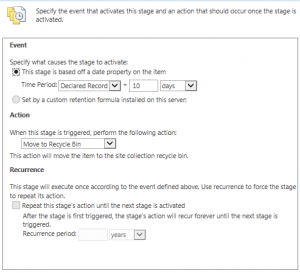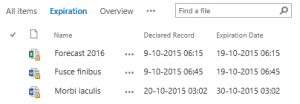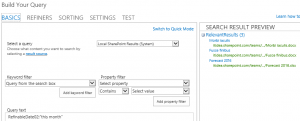This post is written as a follow up and extension of my previous post In-place records overview.
Records management can be implemented in combination with information management policy settings. One of these settings is retention. With retention content can be managed and disposed by specifying one or more stages.
The picture below shows a retention policy where the document will be moved to the recycle bin after it’s declared as a record for 10 days. This is a quite short period of time, but convenient for demo purposes.

Retention policy added to a content type
When using records management with retention policies, where records are declared in-place, stored in a record center or a combination of both, it’s quite hard to list all records that will expire let’s say this month.
Once there is such an overview the documents listed can be checked and eventually owners can be contacted before they’ll get deleted.
One field is automatically added to the library when a document is declared as a record: ‘Declared Record’.
When a retention policy is defined at the used content type an additional field is added: ‘Expiration Date’. This field, in combination with search, can be used to display an overview.
In a library documents of this content type were created and the view was adjusted to show both fields ‘Declared Record’ and ‘Expiration Date’ as show below.

View with Declared Record and Expiration Date fields
With this basic setup in place, we’re almost there… 🙂
In Office 365 there are a couple of predefined refinable date fields (RefinableDate00 up to RefinableDate19) and we need a mapping to the crawled property belonging to the Expiration Date: ‘ows__dlc_ExpireDate’ on one of these fields. Which one you pick doesn’t matter.
This managed property can be used in a Content Search web part by adding the following query to show records to be expired ‘this month’:
RefinableDatexx:”this month”
where xx is the number you used for the managed property name
To show the Expiration Date in the results, the managed property can be used in the property mappings at the properties of the web part.
Eventually a refiner can be added by result type (Word, Excel, etc) or other refiners to be able to refine the results.
Summary
There are no out-of-the-box overviews for records about to expire in SharePoint (Online). Fortunately this can be created easily using a managed property and search.

